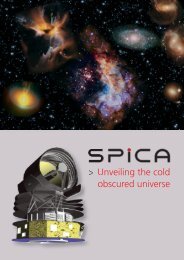SRON_Spectrum_2016
You also want an ePaper? Increase the reach of your titles
YUMPU automatically turns print PDFs into web optimized ePapers that Google loves.
ters of galaxies, and how do black holes grow<br />
and influence their surroundings? However,<br />
they will need to be patient because the<br />
launch of the space observatory is planned for<br />
2028.<br />
Matryoshka dolls<br />
One of the researchers is <strong>SRON</strong> astronomer<br />
Peter Jonker. Last year Jonker and his colleagues<br />
caught a supermassive black hole<br />
tearing a star apart. The black hole was quite<br />
bright in the radio spectrum – there was<br />
already an accretion disk with the flow of<br />
matter moving towards the black hole –<br />
but not so bright in the X-ray spectrum.<br />
“Until a star passed that was being torn<br />
apart,” explains Jonker. “Due to the new<br />
flow of matter into the black hole, it entered<br />
an entirely different mode.”<br />
After this powerful injection of gas, Peter<br />
Jonker and his team observed a strong in -<br />
crease in X-rays and visible light, while the<br />
radio emission became weaker. The radio<br />
emission most likely originates from a jet,<br />
a fast gas flow emitted by the black hole.<br />
This fits exactly in the pattern that is observed<br />
in much smaller stellar black holes. In general,<br />
these are quiet and occasionally experience<br />
an eruption during which they first become<br />
brighter in the X-ray and radio spectra until<br />
the flow of matter is so large that the X-ray<br />
spectrum becomes dimmer, whereas the radio<br />
spectrum decreases by factor of more than 50.<br />
Jonker: “And that pattern was also found for<br />
a supermassive black hole. We call this the<br />
Matryoshka principle, which predicts that all<br />
compact objects in universe that attract<br />
matter behave the same with a correction<br />
based on their mass.”<br />
Medium-sized black holes<br />
To gain a better understanding of this pro -<br />
cess es Jonker wants to use ATHENA to start<br />
hunting for black holes that are not extremely<br />
heavy but are also not stellar, so-called<br />
medium -sized black holes. Up until now the<br />
masses of the candidate medium-sized black<br />
holes are all based on rough estimates. Only<br />
a handful of good candidates are known<br />
but these are located so far away that as -<br />
tronomers cannot determine how large the<br />
orbits of the stars around the black hole are<br />
and therefore cannot calculate the mass of<br />
the black hole.<br />
If we can find a white<br />
dwarf that is being torn<br />
apart then the perpetrator<br />
has to be a medium-sized<br />
black hole<br />
Jonker: “Medium-sized black holes (a thousand<br />
to ten thousand solar masses) can also<br />
tear stars apart but that only happens if a star<br />
comes relatively near. And then the time scales<br />
are much shorter, so you have little time to<br />
make your observation.” Jonker is mainly interested<br />
in white dwarfs that are engulfed by<br />
such medium-size black holes. “Supermassive<br />
black holes can also do that but that only<br />
occurs after such a star has passed the observation<br />
horizon. Therefore we do not see it.”<br />
If we can find a white dwarf that is being<br />
torn apart then the perpetrator must be a<br />
medium-sized black hole. As soon as a radio<br />
or optical telescope has observed such an<br />
event we can then immediately observe it in<br />
the X-ray spectrum using ATHENA. Jonker<br />
also hopes that the intended wide-angle<br />
▶<br />
13<br />
<strong>SRON</strong> <strong>Spectrum</strong><br />
From top to bottom: Hot gas cloud as a consequence<br />
of the Tycho supernova (NASA/CXC/SAO);<br />
Black hole (NASA); supermassive black hole blows<br />
bubbles in the hot gas of the Perseus cluster<br />
(NASA/CXC/SAO/E. Bulbul, et al.).






